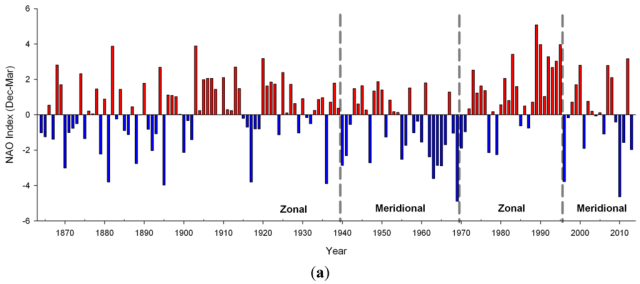To understand the multiply coupled Earth system requires tracing the flow of energy through the relevant physical mechanisms. Over decadal to millennial scales much climate variability emerges from polar regions in changing patterns of meridional (north/south) and zonal (east/west) wind fields that are related to polar surface pressure. Process level models suggest that it is the result in part of solar UV/ozone chemistry in the upper atmosphere translating through atmospheric pathways into surface pressure changes at the poles (Ineson et al 2015). Observations suggest that more meridional patterns are associated with low solar activity (Lockwood et al 2010). There is a further more speculative suggestion that the 20 to 30 year periodicity of the Earth system is caused by the ~22 year Hale cycle of solar magnetic reversal. The next climate shift is due in the next decade if it is not happening now. With a dimming sun – it may be to a yet cooler state in both hemispheres.


Figure 1: An index of (a) polar surface pressures in the Atlantic sector – negative is high polar surface pressure relative to sub-polar surface pressure associated with low solar activity and (b) decadal rates of surface warming and cooling – source Oviatt et al 2015
“Decadal changes in the strength of jet stream westerly winds in both hemispheres alter ocean gyre circulations and together with trade winds, the upwelling intensity off continental margins.” op. cit.
Multi-decadal variability in the Pacific is defined as the Interdecadal Pacific Oscillation (e.g. Folland et al,2002, Meinke et al, 2005, Parker et al, 2007, Power et al, 1999). The latest Pacific Ocean climate shift in 1998/2001 is linked to increased flow in the north (Di Lorenzo et al, 2008) and the south (Roemmich et al, 2007, Qiu, Bo et al 2006)Pacific Ocean gyres. Roemmich et al (2007) suggest that mid-latitude gyres in all of the oceans are influenced by decadal variability in the Southern and Northern Annular Modes (SAM and NAM respectively) as wind driven currents in baroclinic oceans (Sverdrup, 1947). The Pacific state shifts abruptly in 20 to 30 year regimes that sum to millennial variability.
Increased flow in the Peruvian and Californian Currents lead to enhanced cold and nutrient rich upwelling on the eastern margin of the Pacific – and feedbacks across the Pacific in wind, currents and cloud that have global impacts on climate, hydrology and biology. Cloud convection cells persist for longer over cool ocean surfaces than warmer before raining out from the center to let in the sun (Koren et al 2017). Satellite and surface observation suggest that this was the dominant source of warming in the last decades of the 20th century (Clement et al 2009).
